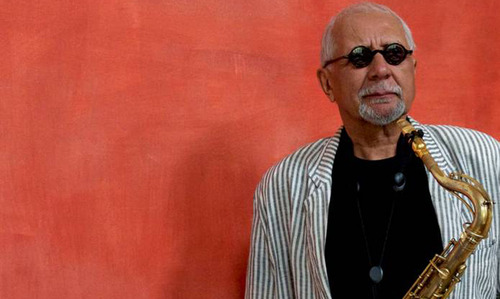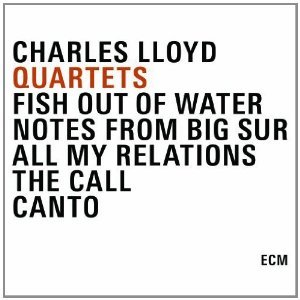
Charles Lloyd
Quartets
ECM (5-CDs) Old & New Masters Edition **** RECOMMENDED
Fish Out of Water, Notes From Big Sur, All My Relations, The Call and Canto are collected here in the by now easily recognisable white box livery of the Old and New Master series were recorded in Oslo between 1989 and 1996. Three of the albums share the same quartet line-up with The Call, All My Relations and Canto able to be exactly compared although on The Call Lloyd restricts himself to tenor saxophone. Fish Out of Water made the greatest impact at the time of release, as Lloyd had not been active on the jazz scene for many years until prompted out of retirement some years before these recordings were made by the enthusiasm of a questing Michel Petrucciani who recorded with him, drummer Son Ship Theus and the Belonging band’s Palle Danielsson, as well as touring extensively. It’s fitting that Danielsson is on Fish Out of Water, along with Swedish pianist Bobo Stenson and ex-Jarrett bandmate Jon Christensen on drums. Christensen’s tenure in the Lloyd quartet as far as these recordings are concerned was brief and apart from Ralph Peterson appearing on Notes From Big Sur it’s Billy Hart who plays on the majority of the Quartets tracks taken as a whole.

Fish Out of Water begins very meditatively and it takes almost 15 minutes, well into the second track, when it’s Stenson who lifts the momentum to which Lloyd responds with that deeply emotional sound of his on the saxophone and the holding pattern melts away. ‘Mirror’ here isn’t the same song as the recent New Quartet album title track incidentally (that melody resembles ‘I Fall in Love Too Easily’ whereas this piano-introduced composition doesn’t). By the end of Fish Out of Water the stately flute is underlining the fact that Lloyd has made a significant comeback.
The big swell on ‘Requiem’, the opening track of Notes From Big Sur, recorded two years later underlines the point of Lloyd’s earlier return and in tandem with Stenson whose role becomes more defined and the fine articulation of Ralph Peterson’s brushes an additional factor Lloyd plays with even greater confidence and the tunes change. You could imagine in ‘Sam Song’ a tune that would have worked for Keith Jarrett like the old days. Whether Lloyd was recreating (via Stenson and casting Peterson as DeJohnette, Anders Jormin as Cecil McBee) is unlikely, but the comparison at times is striking.
Nowadays Jason Moran accompanies Lloyd so differently to Stenson although there is a continuum in the choice of melodies between these two important periods in Lloyd’s career. Lloyd’s style then and now digs deep into his soul and enters the listener’s subconscious eventually. The pick of the tracks could be ‘When Miss Jessye Sings’, a long tune that really unfolds into an exuberantly weary swing, just the sort of beat Lloyd needs when the tears in his sound transform into pure joy in the course of the improvisation.
1993’s The Call introduces Billy Hart whose presence is so important on three of these albums. ‘The Blessing’ is the big tune here (it’s a Lloyd composition, not the tune of the same name by Ornette Coleman), its stillness breathtaking, and Stenson’s African-sounding gently brittle backdrop to the developing improvisation is a masterclass in control. The Swede’s opening statement on ‘Figure in Blue, Memories of Duke’ shows how Stenson can manipulate the descending line of a Ellington-inspired melody routine. No tenor player then or now enters after a piano introduction like Lloyd habitually does, and his first solo here on ‘Figure in Blue’ is just one of many memorable moments of this box set. All My Relations, which Lloyd uses to extend his instrumental palette by paying Chinese oboe, has as its centrepiece a homage to Nelson Mandela in the ‘Cape to Cairo Suite’ begun by Jormin and where Hart comes into his own as cross rhythms stir and shake the band into a new direction. In the course of this journey Lloyd responds magisterially, Coltrane-like just after the three-minute mark: another exquisite sensation. The title track of ‘All My Relations’ is catchily calypso-like within a bebop prism and this also leaves its mark.
The final album, Canto, recorded towards the end of 1996, is the most mysterious of the albums and possibly the greatest of all, and the use of Tibetan oboe has something to do with this on ‘Nachiketa’s Lament’, but it’s more an extension of the unique mood Lloyd through his writing, performance and inspirational presence is able to draw on during these years. There’s a power too and on ‘Durga Durga’ Lloyd testifies like he was simply put on this planet to play this music and to communicate its power, and to transcend.
Stephen Graham
Charles Lloyd top and the cover of Quartets above. Released today.